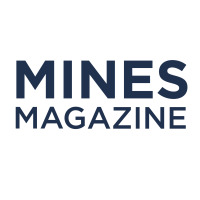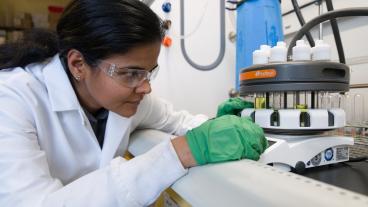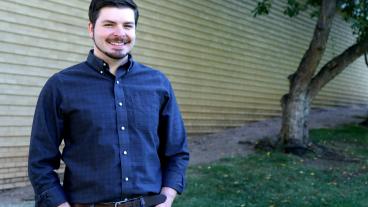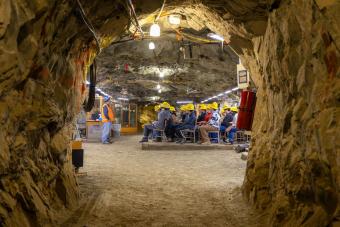
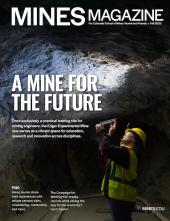
Back-to-school may evoke memories of rushing to class across campus for some, but for mining engineering majors, a different tradition prevails. For these literal Orediggers, going to class often meant donning a hard hat and heading underground to the classroom in the Edgar Experimental Mine.
For more than a century, Edgar Mine in Idaho Springs has been a place where mining students can get hands-on experience that few other universities offer. Now, a generous $1 million gift from Freeport-McMoRan Foundation—the company’s second gift to Edgar over the last decade—has enabled a revitalization of the mine that will let it continue to offer exciting opportunities in the future. New infrastructure being built at Edgar, often by Mines students, is keeping the mine at the forefront of applied education focused on best industry practices and maximizing learning experiences. It’s also opening brand-new doors to innovative cross-disciplinary research and partnerships—giving Mines a leg up on the other 14 U.S. universities that have mining engineering degree programs.
“The Edgar’s really the crown jewel of our program,” said Hugh Miller ’86, MS ’91, PhD ’96, an associate professor of mining engineering and research director of the Energy, Mining, and Construction Industry Safety (EMCIS) Program, which provides mine safety training for industry professionals. “The environment it provides to conduct novel educational and learning activities is second to none.”
Freeport-McMoRan Foundation’s initial gift to Edgar upgraded the mine’s electrical infrastructure. The latest gift will make the mine more accessible and comfortable for visitors: A new bathhouse will have facilities for the Mines community as well as Mine Rescue Training Course attendees, industry and government partners and members of the public touring the mine. A new multipurpose room, excavated by students and faculty, will serve as a learning space for up to 30 people. Potable water, sewer and airflow systems will also get an upgrade.
“The mining department has done a good job of building out a vision of what it can be, and we recognize the importance of it to the entire Mines community and support it as an organization,” said Josh Olmsted ’92, president and chief operating officer-Americas at Freeport-McMoRan.
The mine’s revitalization also means that the opportunities at Edgar are evolving. The unique setting offers students and researchers experiences for education and experimentation across a surprising number of disciplines. Industry and government partners are working with Mines on projects ranging from explosives research to hydrology to petroleum geology and quantum physics.
“Ten years ago, it was very much a mine—it was dusty, it was not in the shape that it’s in today,” said Kyle Leach, professor of physics and science director of the Colorado Underground Research Institute (CURIE) housed within Edgar. “Over the past 8 to 10 years, it has evolved from a teaching tool for the Mining Department to a real research resource across campus.”
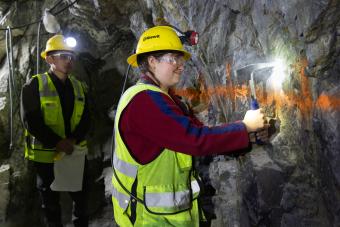
A history of learning
Edgar Mine’s story goes all the way back to Colorado’s gold and silver rush. In its early days, the mine primarily produced silver, lead, zinc and small quantities of gold.
Over the years, ownership of Edgar Mine changed hands many times before the Big Five Mining Company, facing bankruptcy, leased it to Mines for educational and research purposes in 1921. The university eventually acquired the property and developed extensive facilities at the site, including an aboveground area designated for explosives research.
In the mine’s current era, students attend class in a classroom inside the mine, but they also gain working knowledge of rock structures and equipment. They learn how to excavate rock, construct ground support systems and operate drills, rock-bolters, haul trucks and muckers. They also learn how to use explosives and acquire fundamental safety skills and ethics they’ll use at any jobsite. They get real-life design experiences, like planning a new space with modern infrastructure—ventilation, lighting, waste management, communications, road construction and piping networks. They learn to consider the economic viability of what they’ve planned and then actually develop it out of the rock.
The mine’s revitalization is also letting the university build in new capabilities. Mining engineering students have already carved out new spaces for an underground X-ray laboratory and experiments in quantum physics, and more projects are underway.
The Edgar experience
Alexandra Nickle, a senior in mining engineering, was drawn to Mines in part by Edgar. She comes from an engineering family, and growing up, her family’s vacations sometimes included a mine tour.
“What I love about being underground is that it’s not somewhere that humans are meant to be,” she said. “The challenges you have to overcome are interesting—ventilation, water, rock support. I’m an engineer, so I love solving problems.”
Nickle now works as a “shifter” at Edgar while pursuing her degree. It’s a leadership role that has her managing crews during the lab period, leading tours of the mine, teaching fellow students how to operate equipment and handling a number of other tasks underground. It also gives her the opportunity to meet and learn from industry professionals that come to the mine, whether for research, a tour or safety and emergency rescue training.
While the chance to get your hands on equipment can’t be overlooked, the leadership skills required to be an effective shifter are essential for any current role in the mining industry, Olmsted said. He was a shifter, and he said he used the management lessons he learned in Edgar at his first job in the mining industry.
“Being a shifter is a way to grow and gain leadership skills that students might not have otherwise,” Olmsted said. “You might not realize how important those experiences are in the moment, but you look back and say, ‘That was formative.’”
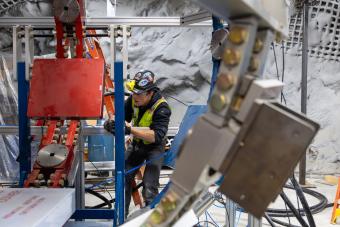
Safety first
There are other skills to pick up at Edgar, and safety is an important one.
In addition to the skills gained through the EMCIS program, graduate students who work with Veronica Eliasson, an associate professor of mechanical engineering and director of the Mines Explosives Research Laboratory (ERL), gain additional and highly specialized training in explosives. Their research group works closely with the U.S. Departments of Defense and Energy and their industry partners.
“When these labs come out and they say, ‘Where are your technicians?’ I point to the students,” Eliasson said. “The students get a full-on experience. For us, it’s about training the students in using the safety protocols as well as diagnostics, so if students want to go work for them, they don’t need to spend two years working from scratch on safety training.”
The safety requirements are intense: Students don’t handle explosives on their own at first, and everything is closely supervised. In addition to the steep training requirements, they’re gaining experience on current research projects ranging from advanced diagnostics and 3D-printed formulations to new techniques for disposing of unexploded ordinance.
Inside Edgar, Eliasson recently guided undergraduate students through the design and development an X-ray facility in the Sunburst drift, which the students expanded. “You can use this to study detonation waves,” Eliasson said of the technique that will be used there. “You can reconstruct it into a 3D movie, sort of like what you get from a CT scan.”
Their research group is also often at the outdoor range, if weather allows. “Up there we have all the cool equipment: high speed cameras, all kinds of sensors, high-fidelity diagnostics,” Eliasson said. “It’s a big space, so we have enough space to be safe and be far enough away.”
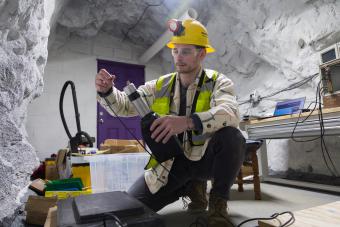
A low-background quantum environment
With the revitalization, Edgar Mine has become a space that’s interesting to researchers outside of mining engineering.
“As Edgar evolved, for those of us who do subatomic physics, we started thinking more and more about how can we use it to search for extremely rare events in the universe?” Leach said.
As mines go, Edgar isn’t as deep as some. But there’s enough rock above to block most of the cosmic radiation that hits Earth’s surface, making it an ideal environment for studying the origins of the universe, said Wouter Van De Pontseele, an assistant professor of physics. He cited an example from his group’s preparatory research in Edgar on subatomic particles called muons. Aboveground, the constant cascade of muons gets in the way of spotting neutrinos—rare, hard-to-detect particles that physicists believe hold the keys to understanding how the universe formed. In the room in Edgar dubbed the Subatomic Particle Hideout, the cascade of muons is more like a trickle.
“A student in our group has been leading the experiments to characterize how many muons there are underground, and there are 700 times less,” Van De Pontseele said. “We used to see a background event once every second, and now we see one once every 15 minutes, just by going 200 meters underground.”
Aside from the radiation-blocking rock overhead, the mine’s constant temperature of 54 degrees Fahrenheit provides a stable environment for sensitive equipment used in particle physics and quantum computing. “Qubits can become unstable in 0.1 milliseconds, and that is partially affected by cosmic radiation, temperature variations and surrounding noise introduced by various sources such as cell phones,” Van De Pontseele explained. “All of these things affect the building blocks of quantum computers.”
There are only a handful of underground labs for this kind of experimentation in the U.S., and because they do not offer horizontal access or are not owned by universities, they’re much less accessible, he said. For Van De Pontseele and Leach, who both have joint appointments at the National Institute of Standards and Technology (NIST) and are partners in the U.S. Economic Development Administration’s Elevate Quantum tech hub, Mines’ ownership of Edgar creates unique opportunities for partnerships in quantum research. “What the Edgar Mine brings to the table is being able to collaborate with scientists and industry while being very nimble in tackling novel challenges quantum technology is facing, Van De Pontseele said.
While the characterization work at the Subatomic Particle Hangout continues, the physics and mining engineering departments are collaborating on the design of the next two quantum-focused labs in the mine. The first, which they’re calling Cryolab 1, will have an ultra-cold refrigerator inside a clean room when it’s up and running—but it’s already providing a hands-on experience for mining engineering and physics students alike.
“When we toured the space that will be Cryolab 1, the mining engineering students who excavated it were fascinated to learn what we were trying to do and wanted to know how they could get involved,” Leach said.
“There’s real cross-pollination between really different areas of science, and that’s a real strength of Mines.”

